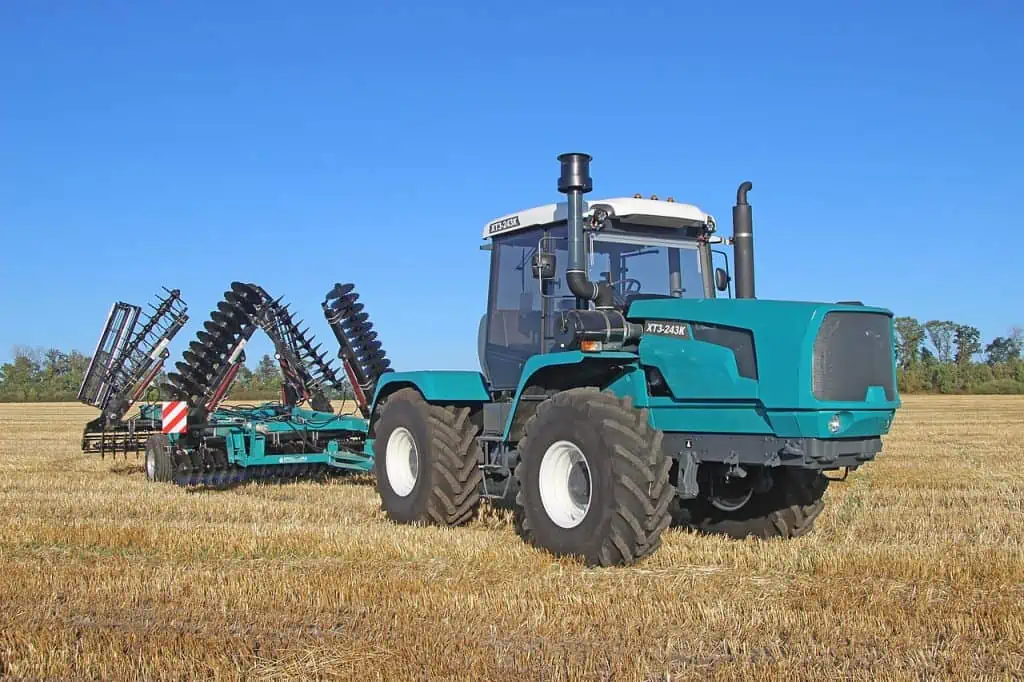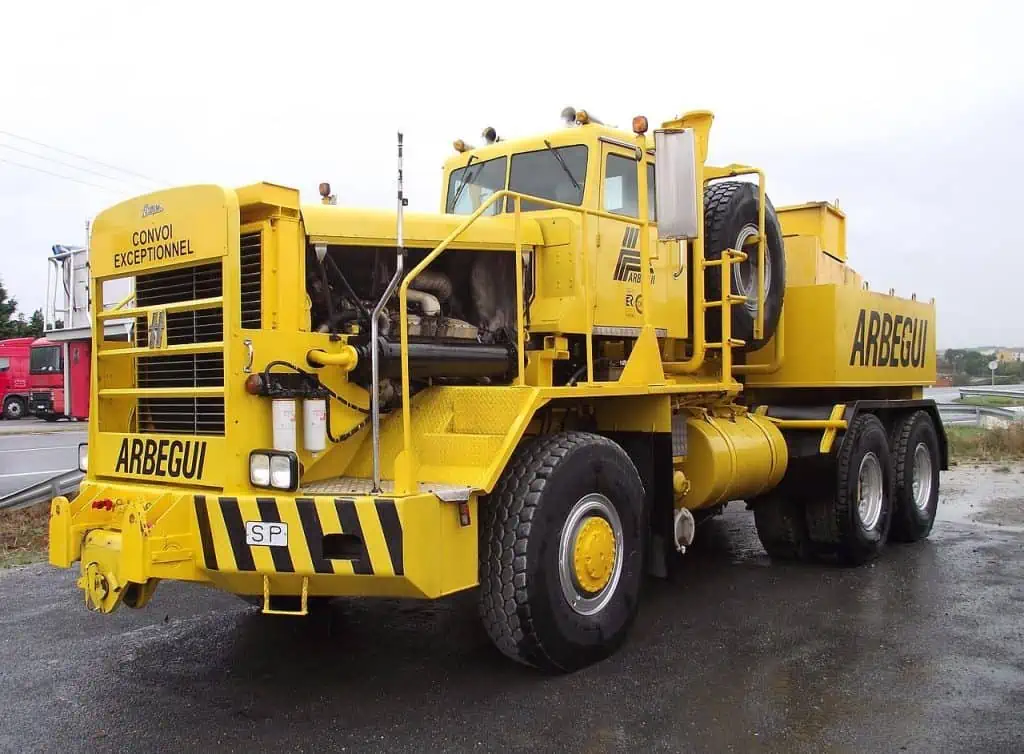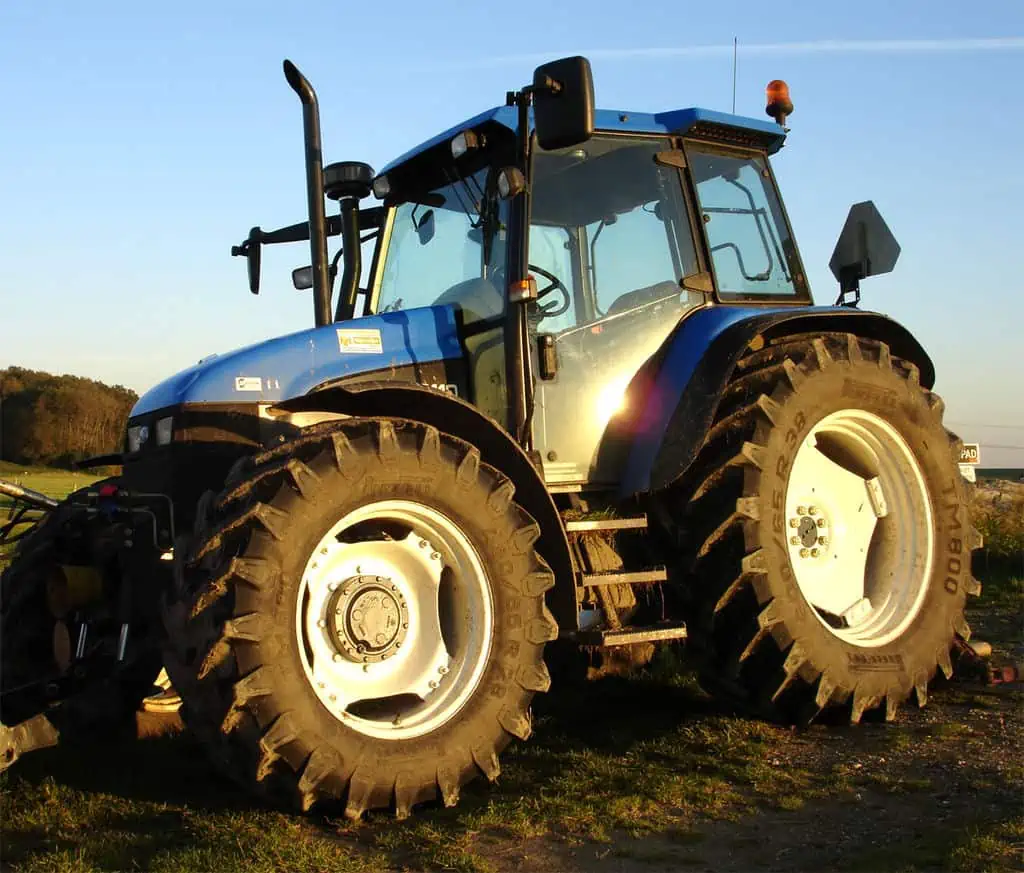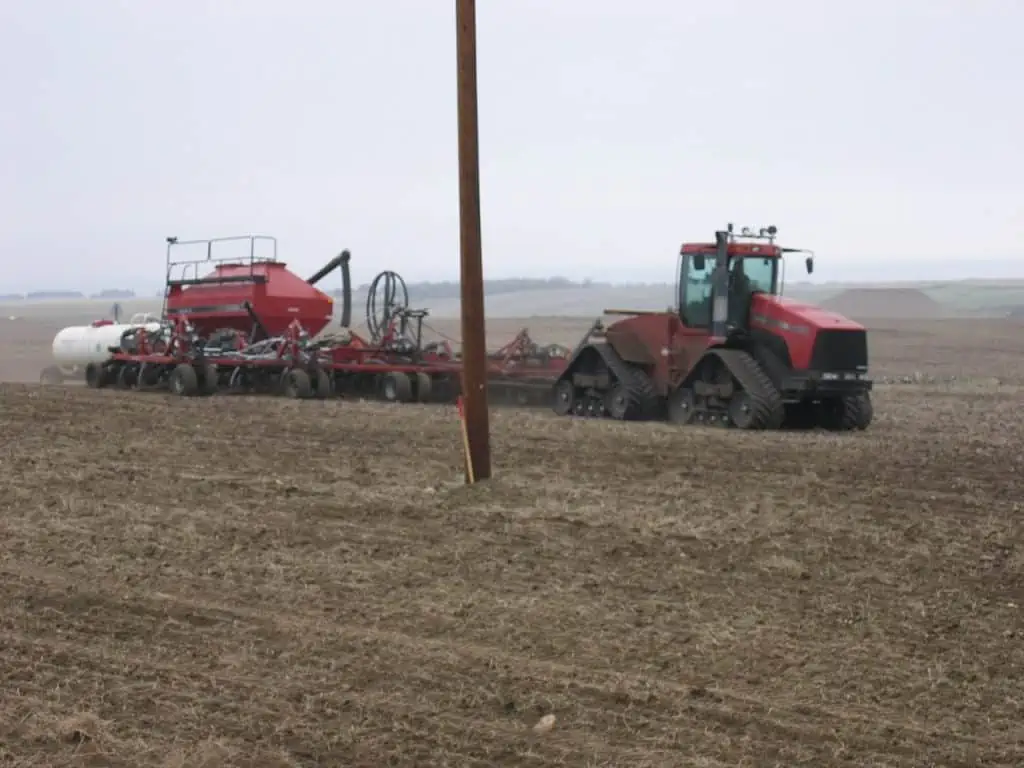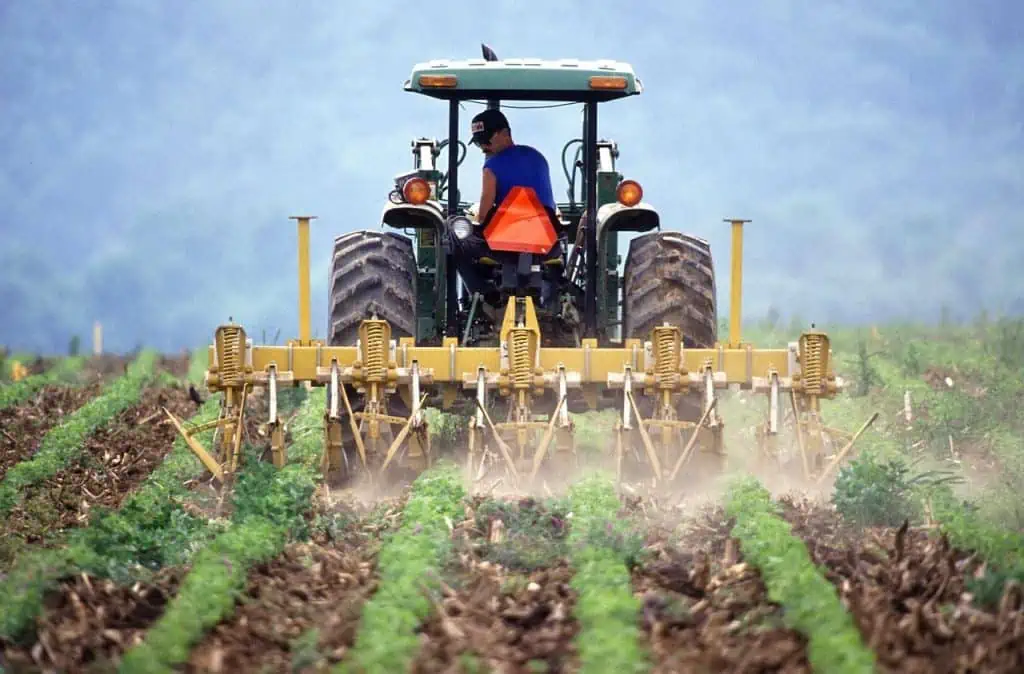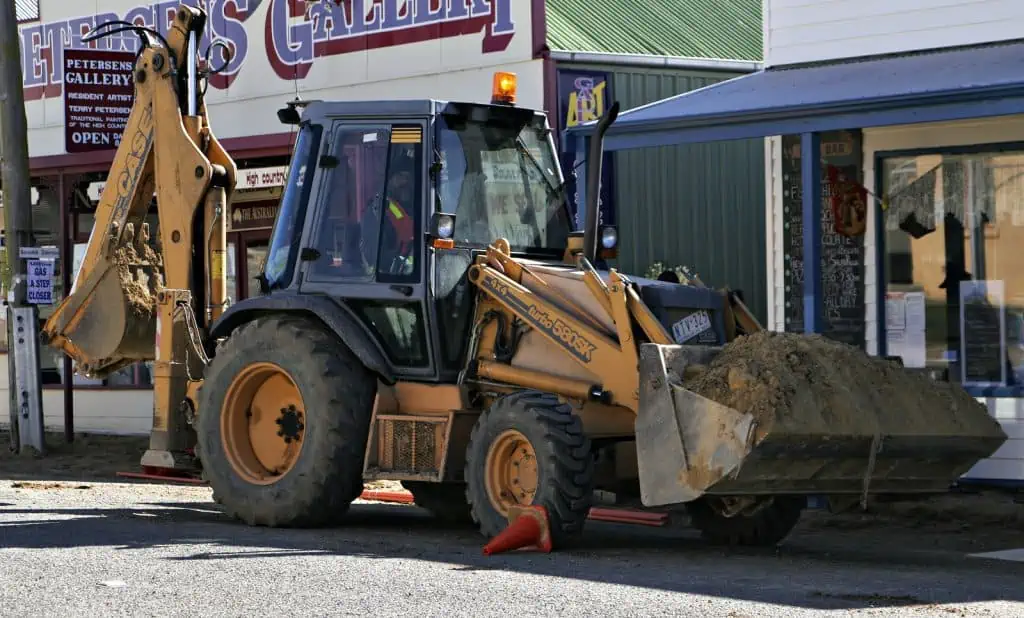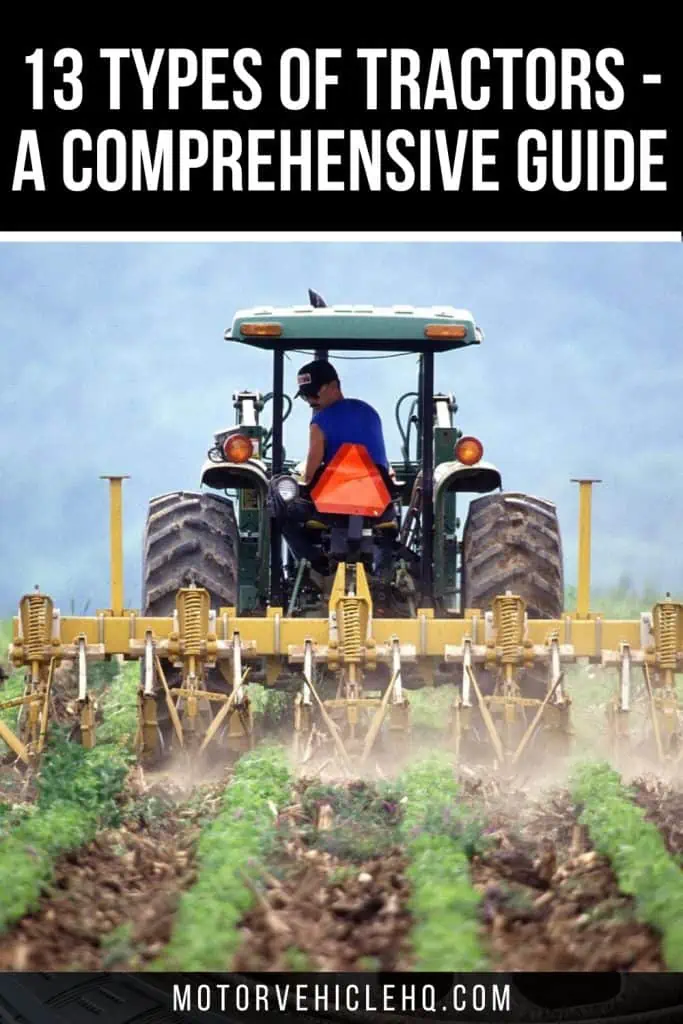A tractor is a vehicle with substantial rear wheels that are used to lift, pull, and push big cargo. Its ability to provide strong traction at moderate speeds is how it got its name. Its primary features are a diesel engine, power steering, and four-wheel drive.
Tractors are frequently exclusively considered as farm equipment, yet types of tractors are employed for duties other than farming, including huge industrial chores, specialized jobs, large earthmoving projects, and modest home projects. Each of these tractors has distinct qualities and applications.
In this post, we discuss the nine basic types of tractors, their applications, and how to choose the best one for your requirements.
The History of Tractors
One of the key industrial revolution byproducts was the tractor. Agriculture has been greatly impacted by tractors ever since they were first used. Steam engines that burned wood or coal propelled early tractors.
These steam engines assisted in propulsion by driving two enormous wheels on a single axle with the help of thick leather belts. Earlier tractors were mainly used to replace hoses, mules, and manpower by pulling tillers across farmland.
The amount of land that could be tilled in a day increased as a result. Unfortunately, due to pressure buildup in the boilers, steam-driven tractors were unreliable and frequently exploded.
While the tractor is in use, the leather belt could easily rip and shred before breaking. The operator was frequently killed or seriously injured as a result of this.
Over the 19th century, steam-driven tractors gained popularity in farms across America and Europe as the industrial revolution began to gradually reach its height in the 1850s.
The tractor was evolving into a three- and four-wheeled vehicle that could be operated as the 20th century drew near.
Modern tractors are more expensive, sophisticated, and sophisticated pieces of machinery. Nonetheless, since their creation, their fundamental use hasn’t changed. Tractors are still made to move objects from one location to another.
Tractors are now made in a variety of sizes and used for other purposes besides only agriculture. A tractor comes in two different basic configurations:
- those that are supported by additional devices.
- those that have additional hardware attached to them in the front, center, or back. A hitch or coupler might be used for the attachments.
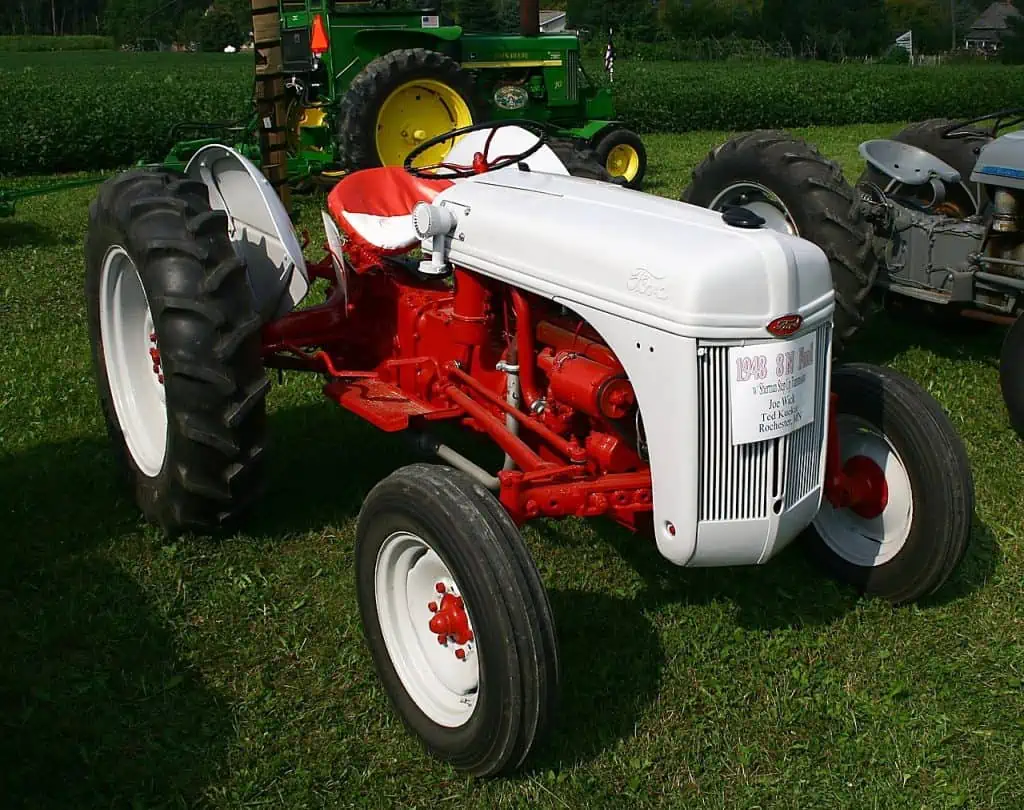
What Type of Equipment Is a Tractor?
A specific kind of vehicle called a tractor is designed to deliver high torque at very low speeds. It can transport heavy equipment or a trailer that is useful for industrial, commercial, and agricultural tasks.
Traction and motor are two terms that are combined to form the word tractor. A tractor mostly aids in pulling huge loads for various farming tasks.
Farmers engage in a wide range of agricultural operations, and equipment and farming implements are necessary for each task. There are numerous types of tractors available to help meet such needs and expectations, depending on the farmer’s requirements.
What are the Different Types of Tractors
Several types of tractors are employed in many fields of labor nowadays. Depending on what they are used for, these tractors can be divided into several categories.
1. The Industrial Tractors
Tuggers, another name for industrial tractors, are vehicles made specifically for industrial settings like building sites. Rather than a three-point hitch as agricultural tractors use, they employ a drawbar to attach implements like crane booms.
They are suitable for off-road use because they have four-wheel drive as well. They are primarily intended to be used for hauling huge loads, such as logs or other goods.
While having a wider range of horsepower and strength than agricultural tractors, industrial tractors are heavy-duty machinery.
Applications of Industrial Tractors
The following are the main purposes of industrial tractors:
Towing the largest loads: Industrial tractors are designed to help you clear land and carry huge loads of commodities like logs across a building site.
High lifting capacity: Industrial tractors are excellent for lifting tasks due to their high power as well as their movable arms and attachments.
Construction and industrial work: Industrial tractors have a wide range of uses on a building site, from moving materials to clearing debris.
2. The Row Crop Tractor
Row crop tractors are similar to hybrid cars in that they combine the capabilities of cultivators like rotary tillers and farm tractors into a single unit.
They are employed in a variety of agricultural operations, including weeding, harrowing, mowing, and pulling seed drills.
To boost pulling capability, they can also be equipped with accessories like threshers, water pumps, sprayers, and heavy-duty lifters, all of which are powered by takeoff (PTO).
The majority of these tractors are simple to steer and have good row spacing capabilities.
Main Applications of Row Crop Tractors
The following are the main purposes of row crop tractors:
Growing row crops: Row crop tractors are capable of carrying out a wide range of agricultural tasks, including weeding, watering, and sowing seeds.
Plowing: These tractors can be used to plow fields and remove debris from the soil, such as snow.
Towing and hauling: They tow bulky loads like farm machinery, agricultural supplies, and other stuff you would need to move.
Modern tractor XTZ-243K by A. Langenfelder / CC BY 4.0. Utility tractors are versatile vehicles with a wide range of applications. They make it possible to use a variety of power take-off attachments, including plows and tillers, as well as perform several agricultural tasks and landscaping tasks, like mowing grass, excavating trenches, and moving dirt or gravel piles.
3. The Orchard Tractors
A unique class of tractors is an orchard tractor. They are specifically intended for usage in orchards, as their name suggests.
As a result of its height, narrowness, and open design, they let the tractor’s operator move easily through the rows of trees in an orchard and even pick fruit while seated inside.
Also, they include tires designed specifically for orchards that have tougher treads to guard against punctures from thorns or other fruit- and flower-related detritus.
They still have the same basic functionality as other tractors, including the capacity to push and pull, as well as the functions of agricultural tractors, including plowing and sowing, in addition to their unique design for orchard use.
Main Functions of Orchard Tractors
The following are the main purposes of orchard tractors:
Pulling and pushing trailers or pieces of equipment: Orchard tractors are prepared to transport farm equipment even though they aren’t as powerful as other types of tractors.
Field or farmland tillage: They are helpful during plowing, especially in confined spaces close to trees.
Planting seeds: These tractors are employed for a range of orchard cultivation duties, such as seeding, plant maintenance, and fruit harvesting.
Tilling or discing: These tractors can be used to prepare orchards for tree growth and disc (till) soil for planting.
4. The Compact Tractors
Compact tractors are diminutive agricultural tractors made for tiny farms or homes. They are easier to maneuver in tight locations and are more suitable for limited acreages due to their compact size.
They typically have a 540 rpm PTO to power accessories. Compact tractors have a three-point hitch, which because of their size belongs to Category 1 like other farm tractors do. Farm tractor categories refer to the number of horsepower that their three-point hitches can support.
That means a Category 1 tractor, such as the compact tractor, has less than 50 horsepower and makes use of lighter-weight tillers, blades, and scrapers.
Main Functions of Compact Tractors
Among the main applications for compact tractors are:
Landscaping: Compact tractors can be used on moderately uneven terrain to complete landscaping jobs like mowing and tilling.
Removing snow: Moreover, they aid in clearing snow from your land during land clearing.
Tugging and dragging: These tractors are outfitted to move supplies or other machinery needed for minor land projects.
5. The Sub-Compact Tractors
Compact tractors in a smaller form are sub-compact tractors. They carry out many of the same tasks as compact tractors, but with a more compact structure and at a lower price. They are best suited for novice tractor owners with small farms or acreages because they are simple to maneuver.
Subcompact Tractors’ Main Applications
Sub-compact tractors are mainly used for:
Hobby agriculture: They are perfect for novice farmers or homeowners working on landscaping projects due to their lightweight construction and simplicity of use.
Mowing confined spaces: Sub-compact tractors are well suited for maneuvering through and taking care of tiny plots of land because of their compact proportions.
Hayes WHDX ballast tractor by Buron444 / CC BY-SA 3.0. Vehicles designed expressly for industrial situations, such as construction sites, are known as tuggers. They use a drawbar to attach tools like crane booms rather than a three-point hitch like agricultural tractors do.
More compact towing and hauling: These tractors can nevertheless tow huge loads even though they lack the power of heavy-duty tractors.
6. The Utility Tractors
Utility tractors are all-purpose automobiles with numerous uses. They enable many power take-off attachments, such as plows and tillers, as well as several agricultural duties and landscaping operations, such as mowing grass, digging trenches, and hauling heaps of dirt or gravel.
Utility tractors typically have between 40 and 100 horsepower. Despite being strong and adaptable, these vehicles are also small and simple to maneuver.
Main Functions of Utility Tractors
Among the utility tractors’ main applications are:
Arduous tasks: Utility vehicles can handle both delicate and difficult tasks, such as moving large machinery, cattle, and other supplies.
Livestock transport: Utility tractors can be used to transport animals, such as cattle, safely to other parts of the farm or to other locations, such as processing plants.
Farming field work: They are helpful for a variety of agricultural operations, including tilling, mowing, and plowing.
7. The Gardening Tractors
Garden tractors, sometimes known as lawn tractors, are tractors made specifically for house owners to use in their gardens or lawns. They are compact and underpowered, often with 1 to 10 horsepower, which is sufficient for most activities a homeowner would face.
Although they have far thicker treads for increased traction and endurance, their tires resemble those of a scooter. They are employed for tasks like mowing lawns and laying out fresh flowerbeds for planting.
Basic Functions of Gardening Tractors
Among the main applications for garden tractors are:
Cutting grass: Garden tractors are designed with lawn-mowing capabilities as their main use, enabling homeowners to operate the mower while seated.
Removing snow: They can be employed to clear snowfall from a small area, such as a yard.
Yard waste movement: They have the strength to move and clean yard trash produced by landscaping projects.
Landscaping: They are useful for many gardening jobs, including grading new flower beds and removing existing ones.
8. The Specialty Tractors
Tractors made specifically for unusual tasks are called specialty tractors. This category of tractor includes a wide variety of genuine types of tractors, each designed for a particular purpose.
Specialty tractors can perform tasks that aren’t often performed by tractors or can be completed in places where conventional tractors can’t, including tight corners or rocky terrain, because they are constructed with complex dimensions and demanding situations in mind.
A few examples of specialty tractors are:
The Narrow Tractors
Narrow tractors can maneuver through and service incredibly narrow sections of land because they are built to twist and turn in especially constrained situations.
The Crawler Tractors
A specific kind of track tractor is a crawler. Crawler tractors are sturdy enough to work on the uneven ground since they are propelled by continuous roller belts, rather than wheels.
The Low Profiles Tractors
Tractors with little ground clearance are referred to as low-profile tractors. Low-profile tractors are often smaller in height than narrow tractors, allowing them to operate in tight locations. Narrow tractors are typically smaller in width.
A modern 4-wheel drive farm tractor by Solitude / CC BY-SA 2.0. Lawn tractors and garden tractors are both types of tractors designed primarily for homeowners to use in their gardens and lawns. They are small and underpowered, frequently having 1 to 10 horsepower, which is adequate for the majority of tasks a homeowner would encounter.
Principal Uses of Specialty Tractors
The following are the main purposes of specialist tractors:
Operations that are specific to rows and trees: Due to their narrow design, narrow tractors may more readily fit between rows of trees and crops, allowing them to follow the natural growth patterns’ twists and turns.
Work on a rocky grade: Crawler tractors can operate securely on steep hills and uneven terrain thanks to their stabilizing tracks.
Jobs in remote locations: Each of these types of tractors is created to complete work in challenging-to-reach locations, regardless of the job area’s low clearance, extreme narrowness, or location on a mountainous, uneven terrain.
9. The Earth-Moving Tractors
The most powerful types of tractors are earthmoving tractors. This type of tractor is strong and incredibly heavy, making it ideal for use on building sites.
They can transport any kind of waste, including dirt, mud, boulders, and lumber, whether it’s for digging a basement, leveling a surface, or aiding in the construction of a dam or quarry.
There are several primary categories of earth-moving tractors:
The Excavators
These earthmoving machines can dig deep and move large amounts of soil or dirt because they are typically employed to excavate the ground. To excavate and move away rubble, their design includes a bucket, arm, and movable rails.
The Bulldozers
For cleaning the land, these earthmoving tractors are fitted with a sizable, vertical blade at the front. Many types of trash, including soil, snow, rubble, and rock, are removed with bulldozers.
The Backhoes
Backhoe loaders work similarly to excavators and are often referred to as rear actors or back actors. Despite being smaller than excavators, they have two working implements: a blade in the front and a digger in the back. This allows them to accomplish two tasks at once.
Principal Uses of Earth-Moving Tractors
Among the main applications for earthmoving tractors are:
Excavating trenches: To dig out trenches and other holes, earthmovers can quickly remove earth from a depth.
Landscape grading: To prepare a surface for use, earthmoving tractors may readily grade and flatten it.
Drilling and mining: Excavating mines and preparing a site for drilling are both made possible by the ability of earthmoving equipment, particularly excavators, to move massive loads of earth and dig deeply.
Application in the surface and undersea operations: Amphibious earthmovers can be used for laying submarine cables and pipelines as well as digging into and underwater, such as in swamps.
Earth and debris transportation and movement: Earthmovers can be used to clear the land of rubbish and transfer soil from cavities they have produced with ease due to their great load-bearing capability.
Cleaning up of a job site: They are effective at clearing debris due to their high horsepower and load-bearing capacity.
Demolitions: Some constructions, such as slabs, concrete footers, and other detritus, can be destroyed by earthmoving tractors, particularly excavators.
A modern 4wd articulated crawler by Elcajonfarms / CC BY-SA 3.0. A crawler is a particular type of track tractor. Because they are powered by continuous roller belts rather than wheels, crawler tractors are strong enough to operate on rough terrain.
10. The Military Tractors
Military tractors are used by the armed forces for high-risk undertakings like construction, demolition, temporary road building, and others. They are referred to as artillery tractors, and they were mostly utilized in the 1970s to transport large military equipment and cannons.
They are designed to traverse a variety of challenging terrain. Military tractors have the same design as commercial, and industrial tractors. To withstand landmines and other explosive devices, their tractor frames and undercarriages have been reinforced.
These tractors can occasionally be constructed to be amphibious or semi-amphibious. They move along on wheels, semi-tracks, and tracks.
11. The Autonomous Tractors
Tractors that are driven or operated by artificial intelligence are referred to as autonomous tractors, driverless tractors, or electric tractors.
These tractors might be the next big thing in farming or business. Computers, GPS, drone technology, and satellites are all used by them. Human tractor operators are not required with autonomous tractors.
At a single location, one operator may manage an infinite number of tractors. Several business insiders contend that a dozen or so would be a more accurate estimate.
The farming community has been enthused by their development for a long time, and this zeal won’t soon fade.
12. The Tractors with Two Wheels
Smaller, lighter two-wheel tractors are used for tilling, plows, and towing smaller implements like harvesters, seeding machinery, and trailers. They are also known as single-axle walk-behind tractors or walking tractors.
Small farms and gardens use these. These tractors are often driven by little gasoline engines, and the users maneuver them from behind.
13. The Rotary Tractors
These “walking type” tractors are typically utilized in smaller fields and fields with varying heights. Even though rotary tillers are tiny enough to fit easily into tight areas and up slopes, these are locations where conventional equipment frequently performs ineffectively.
Since you can swiftly and easily pulverize the soil in that field, you can even attach blades to the tillers to prepare seedbeds. A rotary tiller is simply a motorized cultivator that cultivates soil by rotating tines or blades.
Even though, bulky dirt is transformed into a fine, clod-free bed of soil by this process. Even the skid shoes can be changed to alter the working depth of the tiller.
Your garden bed is ready to be planted with any kind of seeds you like once the earth has been “tilled” with this equipment.
How Can You Select the Ideal Tractor?
It can be challenging to decide which of the several types of tractors best meets your requirements. Here are some queries to think about while choosing the best tractor.
1. Choose Your Desired Drive Train
A gear, belt, or hydrostatic drive train are all options, and you may find any of them with ease. These are some advantages and disadvantages of each of these drive types:
A modern 4wd articulated crawler by Fæ. Low-profile tractors are tractors with small ground clearance. Low-profile tractors can maneuver in confined spaces since their height is frequently less than that of narrow tractors. The width of narrow tractors is often less.
- When operated properly, gear drive trains are incredibly effective and last for a very long time. Some even have features like shear pins and slip clutches that significantly lower the risk of inadvertent damage.
- With their high speed (from zero to eight or nine miles per hour), hydrostatic transmissions feature hydraulic fluid that can shield the engine from damage in the event of an overload or an unintentional object strike.
- The engine protection provided by belt-driven machines is somewhat less than that provided by hydrostatic ones. But, employ caution because the interior belt may really flex or even slip under intense pressure.
2. Think About the Space You Have Available
This can seem like a simple piece of advice, but many people ignore it. Make sure you have enough space to keep your tractor, especially when bad weather starts to fall.
For instance, if you reside in a region that experiences extreme cold, you should usually have a basement or garage to put the tractor in as it may be challenging to start in the winter otherwise.
Also, you need to confirm that the size of the tractor you choose can fit in your space. Moreover, keep in mind that your tractor needs to be maintained all year long and should ideally be kept away from the elements.
3. Identify the Tractor Size You Need
This one is equally crucial. While let’s face it, the idea of owning a huge tractor is exciting, some individuals believe they require extra-large tractors.
If you don’t need it, don’t buy it. Naturally, you also don’t want one that is too little. Serious garden gardeners should often choose something between 14 and 20 HP.
When purchasing a tractor and bringing it home, you should carefully consider its added power and chassis weight. The speeds must also be considered.
Remember that roto-tilling and plowing require speeds of up to one mile per hour, so if your tractor’s top speed is only three miles per hour, it probably won’t be adequate for either of those tasks.
So, when choosing the optimum size for your purposes, speed and horsepower capacity need to be taken into account.
4. It Is Important to Contemplate the Attachments
After deciding the parts you require among the ones that came with your tractor, keep two things in mind. First, can you swiftly and simply attach and uninstall the attachments?
Can you switch them back and forth without taking too long to do so, secondly? The three-point hitch on a conventional farm tractor makes it very simple to exchange equipment.
A standard-sized tractor is typically your best option because tiny tractors frequently simply cannot perform this. Think about the following advice as well:
- Once the mower is in position, you may change the tension on each belt by reaching underneath the mower and making sure your hands can reach the adjustment locations.
- Consider yourself changing the tension of each pulley belt, bolt, pin, and spring clip as this is the only way to be certain that the task can be accomplished on that specific machine pleasantly and without harming yourself.
- As you get the tractor home, consider if you’ll be able to see anything underneath it and whether you’ll have to do this while laying on your back on soggy grass.
In other words, while you’re looking for tractors, think about your attachments from every viewpoint possible because you’ll probably have to deal with them frequently once you bring them home.
5. How Long-Lasting Is the Machine You Want to Buy?
If you’re only looking at tiny tractors, you might want to start by checking the axles, drag rods, and linkages. Can the axles on this machinery handle it if earth or rocks fall during use without wrecking the tractor?
A common Case backhoe loader by Fir0002. Backhoe loaders, sometimes known as rear actors or back actors, function similarly to excavators. They have two working tools, a blade in the front and a digger in the back, despite being smaller than excavators. They can thus complete two activities at once thanks to this.
After a year or so of consistent garden work, a half-inch axle may begin to malfunction, making that specific tractor unlikely to be practical to purchase.
Consider the worst-case situations and determine whether the tractor you’re thinking about buying is robust enough to withstand the tasks you have in mind for it. It is preferable to switch to another tractor if accessing the engine to repair it or the wires to replace them is difficult.
In the end, you will be happier if you are conscious of your requirements and insist on having something that meets them. After all, you deserve to have what you want.
Why Rent Versus Buy a Tractor?
While owning a car has its benefits, renting a tractor can be more cost-effective than buying one. Although agricultural tractors are becoming more and more popular, with a predicted $81.4 billion global market by 2027, the majority of individuals still cannot afford to buy one entirely.
As tractors are used more frequently in fields besides agriculture and construction, such as in schools, hobby farms, by landscapers, and by homeowners, renting them makes them more available to a wider range of people, offloading maintenance costs and enabling the user to test out different tractor types per their needs.
What are the Benefits and Drawbacks of Tractors?
The tractor machine has advantages and disadvantages that affect its use in agriculture. You can modify this according to your needs and level of productivity when working on agricultural land.
Benefits of Tractors
1. Faster Workflow
Assuming you plow the area manually, it would cost more money and take more time on rice fields and plantations.
Instead of using manual tools like hoes, you can plow your property more quickly and effectively by using a tractor. This is the main justification given by farmers for using tractors to improve their land.
2. Improved Soil Outcomes
Using a tractor also has the advantage of producing improved soil yields. This is so that the soil that is loosened by using a tractor and a machine is deeper; when the soil yield is better, the plants planted on it can also produce better yields.
But, if you use a digger, the hoe’s power may affect how evenly the soil is released, leading to unequal results.
3. Simple to Use
One of the easier-to-use plowing equipment is the tractor. One of the easier-to-use plowing equipment is the tractor. While using a tractor, all you have to do is start the engine, drive the tractor, and then point it in the same direction as the soil you want to release.
4. Exceptional Harvest
The tractor’s fourth advantage is that it produces higher-quality harvests. According to the tractor’s benefits, which increase soil productivity. As a result, crop yields are closely related to the soil’s quality before cultivation. Later harvesting will produce better yields if the soil is looser.
5. Low Production Costs
The tractor also has the advantage of lowering production costs. This is because using a tractor makes work more efficient. In comparison to using the manual approach, you can minimize your daily spending more if the work is completed quickly.
The Drawbacks of Tractors
1. Activate Pollution
The tractor engine suffered from this equipment’s ability to pollute the air. A chemical, organic, or physical substance must be present for there to be air pollution, which puts all living beings on the planet in peril.
2. Employing Chemicals
Farm tractors are hindered by their usage of chemicals, which are pure substances with distinctive qualities and a predictable pattern of compound synthesis.
3. Fueling Up
Since tractors are powered by machines, maintenance costs are required in addition to fuel costs. The tractor cannot operate for use without fuel. Fuel may be used to create energy since it contains heat energy that can be released and changed. Tractors can run on a variety of fuels, including kerosene, diesel, gas, and LP gas.
The Conclusion
We hope that this information has been useful to you in your hunt for the best tractor for the job. The need for capable Agricultural equipment has arisen as a result of global population growth and an increase in the percentage of hungry people.
Producing the bulk crop requires efficient machinery, and the tractor is one such invention that boosts agricultural output. These many types of tractors will give you a better understanding of the different machines that are used all around the world.
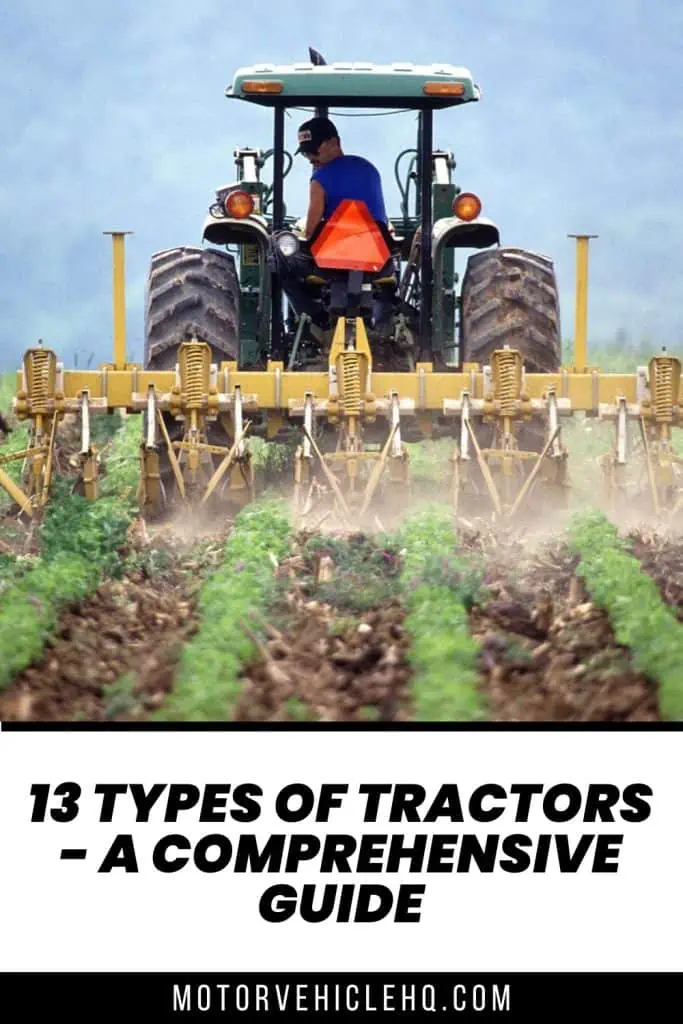
A modern 4wd articulated crawler by Fæ

Jim Wicks is the founder of MotorVehicleHQ. With over two decades of experience in the automotive industry and a degree in Automotive Technology, Jim is a certified car expert who has worked in various roles ranging from a mechanic, car dealership manager, to a racing car driver. He has owned more than 20 cars over the past 15 years. Ask him about any vehicle you see on the road and he can tell you the make, model and year. He loves the aesthetics of all things cars, and keeps his vehicles in pristine condition.
In his free time, Jim enjoys getting his hands dirty under the hood of a classic car or taking long drives along the country roads. His favorite car? A 1967 Shelby GT500, a true classic that, according to Jim, “represents the pure essence of American muscle.”
